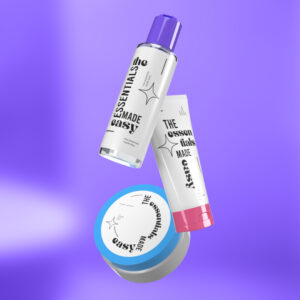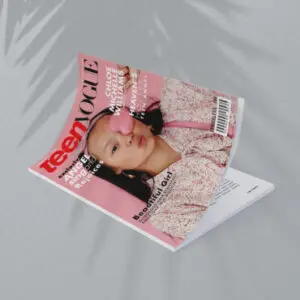
Have you ever seen an attention-grabbing shop display that you just had to go inside and check out the products?
Such is the power of merchandising design – a critical aspect of the retail world, covering everything from product layout and display to packaging and branding.
According to the National Retail Federation, shoppers spend 20% more time in stores with well-designed visual merchandising. But the impact doesn’t stop at brick-and-mortar locations—Shopify reports that implementing omnichannel visual merchandising can increase online sales by an impressive 15%.
Whether you’re looking to boost foot traffic or drive conversions online, the right merchandising design strategy can transform customer experiences and deliver measurable results.
What is Merchandising?
Before we discuss merchandising design, let’s first define what merchandising is.
Merchandising refers to promoting and selling products, typically in a retail setting. It involves a range of activities, including:
- Selecting and sourcing products
- Pricing and displaying them in a visually appealing manner
- Marketing them to customers
The Goal of Merchandising
Merchandising aims to create a positive customer experience that encourages them to purchase. It can be used in various settings, including brick-and-mortar stores, e-commerce websites, and events such as trade shows or pop-up shops. That said, effective merchandising strategies can help businesses increase sales and build brand awareness.
What is Merchandising Design?
Merchandising design is the process of creating visual displays and presentations of products in a way that is appealing and engaging to customers.
It involves designing and arranging products, displays, and signage to effectively communicate the brand’s message and entice customers to make a purchase. Merchandising design encompasses a wide range of elements, including:
- Product layout
- Product packaging design
- Signage
- Lighting
- Music and scents in a store
One component of merchandising is visual merchandising, which uses colors, lighting, and decor to generate interest. To illustrate how this applies to a brick-and-mortar store, let’s take the L’OCCITANE Sunshine Store as an example:

Image Source: L’OCCITANE
According to the brand’s press document released in 2017, L’OCCITANE aims to light up its stores with “the simple authenticity of Provence.” But more than the warm colors and elegant fixtures, the brand stepped up its game by designing its store to offer an immersive customer experience.
For one, store visitors are welcomed in a luxe hands station, where they can exfoliate and hydrate their hands and try out the brand’s hand cream.
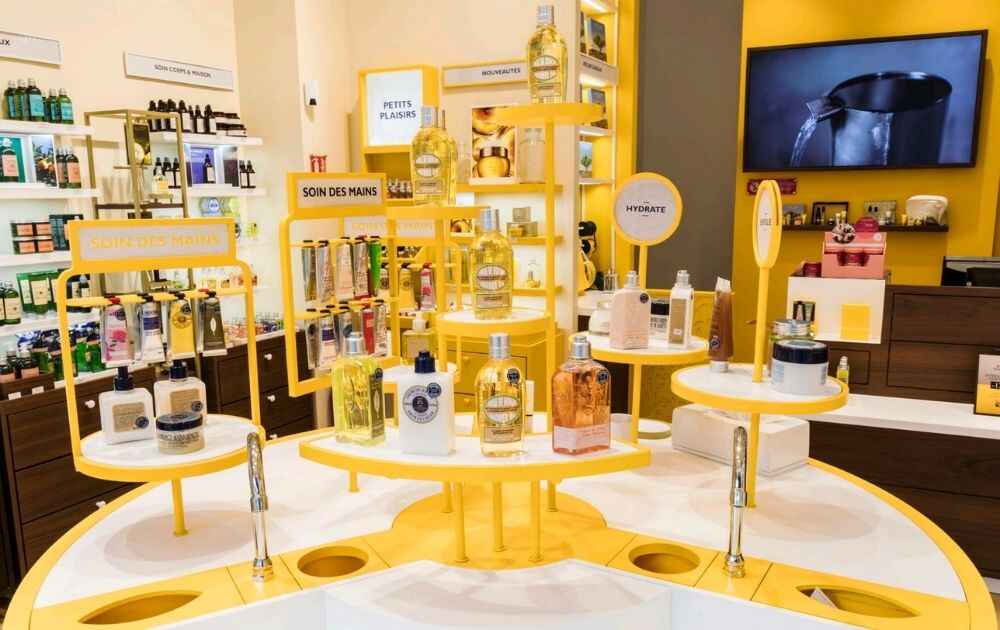
Image Source: L’OCCITANE
In addition, guests can browse and try products at the fragrance and skincare sections. There’s also an elegant lounge where guests can check out handmade gift ideas and personalization options.
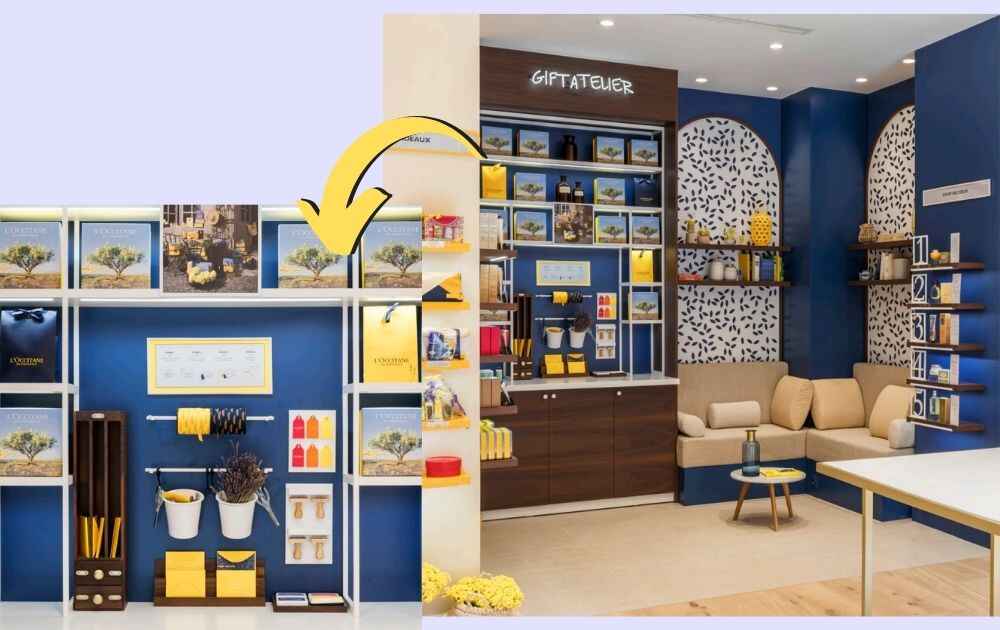
Image Source: L’OCCITANE
This case study shows that merchandising design can make all the difference in creating a strong brand. It can combine elements of visual, auditory, and sensory elements to build a memorable shopping experience for customers.
eCommerce Application: What is Digital Merchandising Design?
Merchandising design sounds exciting for brick-and-mortar stores. But what about eCommerce ventures?
That’s where digital merchandising design comes in – creating visually appealing and engaging digital displays and presentations of products, services, or content. Merchandising design involves designing and arranging digital elements, such as product images, videos, animations, and text, to communicate the brand’s message effectively and entices customers to purchase or take a desired action. Aside from eCommerce websites, it can also be applied to social media, mobile apps, and digital signage.
Like digital advertising design, merchandising design for digital channels must make the most out of available elements to entice customers. After all, prospects will be viewing the store through a screen, unlike in a physical store where they can be immersed in a sensory experience.
To illustrate how you can apply visual merchandising design to eCommerce stores, let’s take a look at this example from TWG.

Image Source: TWG
Remember how L’OCCITANE welcomed its visitors with an elegant hand station that showcased its iconic products? TWG did the same but digitally. Its homepage featured a promo image for Ramadan featuring Alexandria Tea, described as a “dreamy reminder of Arabian nights.”
Scrolling further down the homepage, you’ll find products related to Iftar (the fast-breaking evening meal of Muslims during Ramadan).
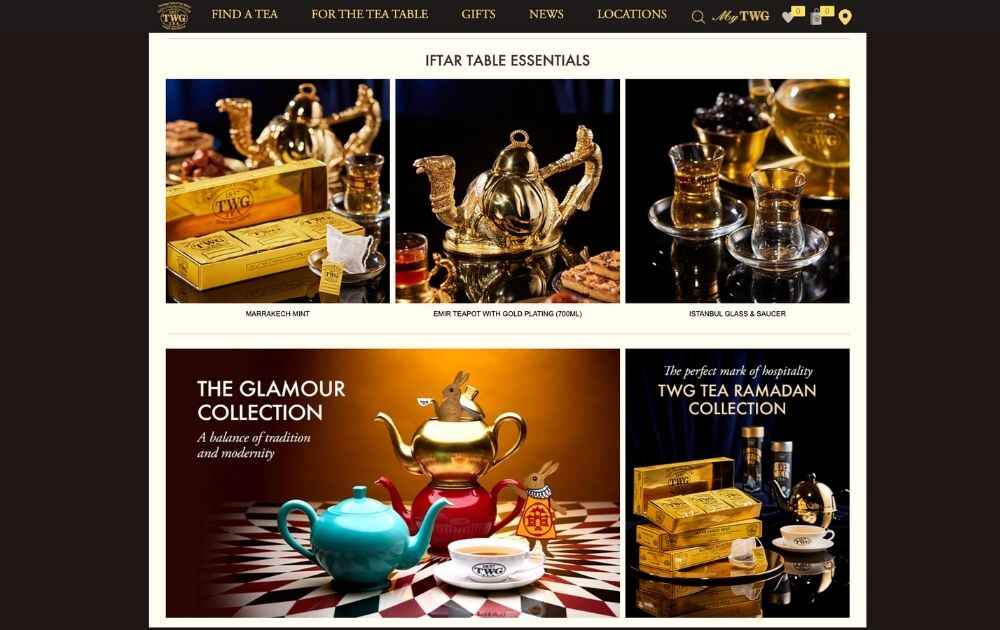
Image Source: TWG
This digital visual merchandising example incorporates products into prospects’ lifestyles, creating a memorable customer experience. Though website visitors can’t touch or taste products, the visuals are enough to make them appreciate their value and inspire them to purchase.
TIP: When you’re banking on your products’ visual appeal alone, you need to ensure that you have professionally-crafted images that will make them click the add-to-cart button. Professional package design services can also help a lot in making your products reflect your brand identity.
Digital Merchandising Design Tips and Tricks
Here are some top tips to consider when designing your digital merchandising strategy:
- Prioritize visual appeal. Digital merchandising design should be visually appealing, with high-quality product images and a clear layout that makes it easy for customers to browse and find what they’re looking for. Use clear and consistent branding across your site to create a cohesive look and feel. Never settle for less than the top 2 percent of designers for your website graphic design needs.
- Optimize for mobile. With more and more customers shopping on their mobile devices, it’s essential to ensure that your digital merchandising design is optimized for mobile. Ensure your site is responsive and has a mobile-first design that makes it easy to navigate and purchase products on smaller screens.
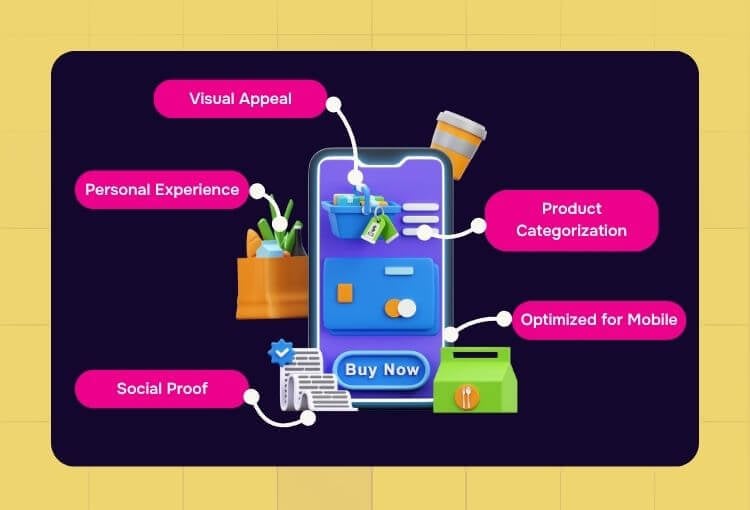
- Personalize the shopping experience. Use customer data to personalize the shopping experience, such as displaying recommended products based on previous purchases or search history. Use dynamic content and personalization tools to provide a tailored experience that enhances the customer’s journey. In addition, maximize the benefits of eCommerce AI to achieve innovative, personalized recommendations.
- Utilize effective product categorization. Proper categorization and organization of your products can help customers find what they’re looking for quickly and easily. Use clear and concise product names, descriptions, and tags to make searching and filtering easy.
- Display social proof. Displaying customer reviews, ratings, and testimonials can be a powerful way to build trust and credibility with potential customers. Consider displaying social proof prominently on product pages and using it to inform customers of the quality and reliability of your products.
By following these tips, you can create an ecommerce store that maximizes sales and enhances the customer experience.
How to Use Graphics to Boost Merchandising Design
Here are a few ways you can use graphics to boost your merchandising design, along with awesome designs crafted by our designers here at Penji.
1. Use Bold Visuals to Draw Attention
Bold visuals are essential in merchandising design because they immediately grab attention and make a lasting impression. Since 55% of brand first impressions are visual, you can make your product or promo stand out by using:
- Vibrant colors
- Eye-catching imagery
- Strong design elements
For example, the visual merchandising design above captures attention with bright colors, high-quality images, and playful patterns that align with the pool relaxation theme. Together, these elements draw the viewer’s eye and encourage engagement.
- Actionable Tip: Keep the layout clean to not overwhelm your audience and ensure the visuals align with your brand identity.
2. Enhance Branding Through Consistent Design
Consistency in design strengthens your brand identity and maintains a look that builds trust. That said, having a branding kit is crucial to ensure that your main visual elements stay the same, including:
- Logos
- Color palette
- Typography
For instance, this website design shows brand consistency through the uniform use of colors, typography, and graphic elements that align with the product’s eco-friendly and health-conscious image.
- Actionable Tip: As part of merchandising best practices, review examples of brand guidelines and develop a style guide that you can apply to all your merchandising materials.
3. Create Engaging Product Displays
Engaging product displays combine visuals, information, and layout to showcase products in a way that captures attention and communicates value.
Aside from in-store layout design and product display strategies, graphic design services can also use this principle in eCommerce merchandising, as seen in this example:
The use of bold colors and appetizing visuals draws the viewer’s eye, while the detailed information (such as cooking methods and nutritional facts) builds trust and provides utility. In addition, the cohesive design ensures that customers immediately associate the product with quality and convenience.
- Actionable Tip: Arrange elements thoughtfully to balance aesthetics with functionality, ensuring customers can quickly understand the value of your product.
4. Leverage Digital Signage for Dynamic Visuals
Digital signage brings visuals to life through movement, color, and interactivity to grab attention. By leveraging dynamic displays, brands can convey multiple messages in a short time, making the content more engaging and impactful in both retail and event settings.
For instance, this design is perfect for dynamic digital signage, given its bold, abstract shapes and striking typography:
Imagine these elements animated—icons shifting or text expanding—bringing energy to an event or retail space.
- Actionable Tip: Learn how to use the color wheel to be able to use color palettes that don’t overwhelm the viewer.
5. Integrate Graphics Into Packaging
Packaging serves as more than just a container for products—it’s a key touchpoint that influences purchase decisions. Whether you’re using package design services or packaging design as a service platform, professional design can enhance product appeal, communicate key information, and build a cohesive identity that stands out on shelves.
For example, take a look at the cookie package retail design set above. The use of vibrant colors, playful fonts, and creative graphic elements conveys both fun and sophistication. The “splash” design around the cookie emphasizes freshness and flavor, while clear labeling of THC and CBD content ensures transparency.
- Actionable Tip: Keep your designs consistent across product lines for a recognizable brand presence and consistent retail merchandising.
6. Utilize Graphics for Promotional Campaigns
Graphics play a pivotal role in promotional campaigns by visually communicating events like:
- Limited-time offers
- Seasonal themes
- Product highlights
Eye-catching digital merchandising designs help products stand out, increase recall, and encourage impulse purchases, especially during festive or high-demand seasons.
In the example above, the holiday-themed promo graphic combines bold typography, festive elements (such as ornaments and pine branches), and a rich red background. These elements evoke the season’s warmth, making it one of the most popular merchandising techniques during the holidays.
- Actionable Tip: Ask your graphic design services provider to incorporate seasonal elements into your promotional graphics to align with current customer sentiments. Also, it pays to ensure that the design maintains a balance between festive flair and brand identity.
Final Thoughts: Elevate Your Merchandising Game with Penji
Great merchandising design is a must for standing out in today’s crowded eCommerce landscape. Whether you’re running an online store, launching a new product, or in need of a branding package, your visuals can make or break the customer experience.
However, creating high-quality merchandising graphics can be time-consuming and expensive—unless you have the right design partner.
That’s where Penji comes in.

With an unlimited graphic design subscription, you can:
- Access the world’s top 2% designers
- Submit unlimited design requests
- Enjoy a fast turnaround time
- All at a flat monthly rate—no hidden fees
Check out our portfolio and see why Penji is the preferred design service provider by brands of all sizes.
About the author

Carla Deña
Carla is a journalist and content writer who produces stories for both digital and legacy media. She is passionate about creativity, innovation, and helping small businesses explore solutions that drive growth and social impact.
Table of Contents
- What is Merchandising?
- The Goal of Merchandising
- What is Merchandising Design?
- eCommerce Application: What is Digital Merchandising Design?
- Digital Merchandising Design Tips and Tricks
- How to Use Graphics to Boost Merchandising Design
- 1. Use Bold Visuals to Draw Attention
- 2. Enhance Branding Through Consistent Design
- 3. Create Engaging Product Displays
- 4. Leverage Digital Signage for Dynamic Visuals
- 5. Integrate Graphics Into Packaging
- 6. Utilize Graphics for Promotional Campaigns
- Final Thoughts: Elevate Your Merchandising Game with Penji


